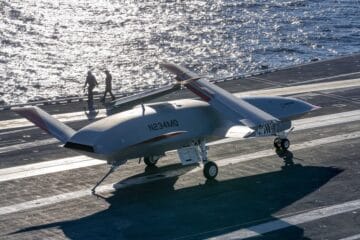“We must move decisively to modernize U.S. naval power as we maintain readiness and a forward posture that keeps America and our Allies safe and prosperous. The Navy is adopting a more continuous, iterative force design process to focus our modernization efforts and accelerate the capabilities we need to maintain our edge in this critical decade and beyond.”
Admiral Michael Gilday, Chief of Naval Operations, U.S. Navy
The desired force level by 2045 calls for:
- 12 Columbia-class ballistic missile nuclear-powered submarines
- 12 CVN Nimitz and Ford-class nuclear-powered aircraft carriers
- 66 attack submarines and large diameter payload boats (current SSNs and next-generation SSN(X). The “large diameter payload boats” could refer to submarines outfitted for hypersonic missiles that are larger in diameter than the current U.S. Navy’s Vertical Launch System (VLS) cells. This could also replace the four Ohio-class Tomahawk cruise missile submarines (SSGNs) that carry 154 Tomahawks each.
- 96 large surface combatants such as the current Arleigh Burke-class and Zumwalt-class destroyers and the upcoming next-generation destroyer, DDG(X)
- 56 upcoming Constellation-class guided-missile frigates
- 31 amphibious ships (LHAs, LHDs, and LPDs)
- 18 upcoming Light Amphibious Warships (LAW) for the U.S. Marine Littoral Regiments (MLRs)
- 82 combat logistics ships
- 150 unmanned surface and subsurface vessels that will act as “sensors and shooters” for the Fleet (although there is debate on what types and if the MUSV is actually needed).

The CNO’s NAVPLAN 2022 Aviation Plan calls for:
- 1,300 5th generation carrier aircraft and that might include the Next Generation Air Dominance fighters and unmanned aerial vehicles
- 900 anti-submarine and anti-surface warfare, to include helicopters and maritime patrol and reconnaissance aircraft and unmanned aerial systems
- 750 support aircraft to include training, lift, and research and development planes.
Author’s Comments on NAVPLAN 2022
Analysis of the CNO’s NAVPLAN can be found at the United States Naval Institute.
The U.S. Navy has admitted to the Media that conventions, policies and procedures, and potential responses to such incidents for unmanned surface and subsurface vessels still need to be fleshed out and are still undergoing discussions and reviews.
For instance, if a hostile maritime party were to capture, sabotage, hack, hijack, damage, sink, ransom, or board an unmanned vessel without one U.S. Navy sailor or Marine aboard, how should the U.S. Navy and the U.S. Department of Defense respond? Would that be considered an Act of War against the United States? What levels of at-sea escalation are required before a manned naval response is dispatched to investigate? When do “unmanned and expendable” vessels become “precious and essential” to U.S. National Security and thus dictate that these unmanned vessels should not be damaged, touched, and harmed in any way? When does the diplomatic approach fail to warrant the use of force over these oceangoing robots? When does Artificial Intelligence (A.I.) become more valuable and secret than just codes, software, data transmissions, and the steel and aluminum the A.I. sails?
Hopefully, these policies and procedures for U.S. Navy unmanned vessels will be solidified by 2045 or sooner.






